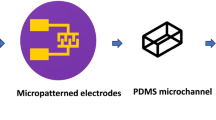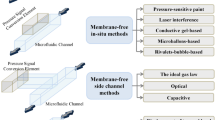Abstract
A novel equivalent circuit model of capacitively coupled contactless conductivity detection (C4D) on microfluidic chips is presented. The impedance of the solution in microchannels facing the two electrodes for C4D was first introduced in the model of C4D on microfluidic chips. The electrodes and the solution facing electrodes were divided into individual segments in the model, and the effect of the length of divided segments on the model was studied. A back-calculating method was put forward to calculate the stray capacitance between the electrodes, and the variation between the calculated value and the simulated value was only 6 %. To evaluate the accuracy of the model, a hybrid poly (methyl methacrylate) (PMMA)/polydimethylsiloxane (PDMS) microchip was fabricated and a simple model was built. Compared with the outputs of the simple model, the data predicted by the novel model show a much closer fit to experimental results, and the variations were within 8 % over a wide concentration range of 1–500 μm for potassium chloride.






Similar content being viewed by others
References
Becker H, Mühlberger H, Hoffmann W, Clemens T, Klemm R, Gartner C (2008) Portable CE-system with contactless conductivity detection in an injection molded polymer chip for on-site food analysis. Microfluidics, BioMEMS, and Medical Microsystems VI 6886:68860C-1-68860C-7. doi:10.1117/12.773579
Brito-Neto JGA, da Silva JAF, Blanes L, Lago DoCL (2005) Understanding capacitively coupled contactless conductivity detection in capillary and microchip electrophoresis. Part 2. Peak shape, stray capacitance, noise, and actual electronics. Electroanalysis 17:1207–1214. doi:10.1002/elan.200503238
Chen ZG, Li QW, Li OL, Zhou X, Lan Y, Wei YF, Mo JY (2007) A thin cover glass chip for contactless conductivity detection in microchip capillary electrophoresis. Talanta 71:1944–1950. doi:10.1016/j.talanta.2006.08.040
Coltro WKT, Lima RS, Segato TP, Carrilho E, de Jesus DP, do Lago CL, da Silva JAF (2012) Capacitively coupled contactless conductivity detection on microfluidic system-ten years of development. Anal. Methods 4:25–33. doi:10.1039/c1ay05364g
da Silva JAF, do Lago CL (1998) An oscillometric detector for capillary electrophoresis. Anal Chem 70:4339–4343
Du LQ, Chang HL, Song MC, Liu C (2012) A method of water pretreatment to improve the thermal bonding rate of PMMA microfluidic chip. Microsyst Technol 18:423–428. doi:10.1007/s00542-012-1466-4
Effenhauser CS, Bruin GJM, Paulus A, Ehrat M (1997) Integrated capillary electrophoresis on flexible silicone microdevices: analysis of DNA restriction fragments and detection of single DNA molecules on microchips. Anal Chem 69:3451–3457. doi:10.1021/ac9703919
Fang XX, Zhang HQ, Zhang F, Jing FX, Mao HJ, Jin QH, Zhao JL (2012) Real-time monitoring of strand-displacement DNA amplification by a contactless electrochemical microsystem using interdigitated electrodes. Lab Chip 12:3190–3196. doi:10.1039/c2lc40384f
Fercher G, Haller A, Smetana W, Vellekoopt MJ (2010) End-to-end differential contact less conductivity sensor for microchip capillary electrophoresis. Anal Chem 82:3270–3275. doi:10.1021/ac100041p
Johnston SE, Fadgen KE, Tolley LT, Jorgenson JW (2005) Expanded electrical model of a contactless conductivity detector: development and verification. J Chromatogr A 1094:148–157. doi:10.1016/j.chroma.2005.07.098
Kubáň P, Hauser PC (2005) Effects of the cell geometry and operating parameters on the performance of an external contactless conductivity detector for microchip electrophoresis. Lab Chip 5:407–415. doi:10.1039/b418845d
Kubáň P, Hauser PC (2008) Evaluation of microchip capillary electrophoresis with external contactless conductivity detection for the determination of major inorganic ions and lithium in serum and urine samples. Lab Chip 8:1829–1836. doi:10.1039/b802973c
Kubáň P, Hauser PC (2011) Capacitively coupled contactless conductivity detection for microseparation techniques—recent developments. Electrophoresis 32:30–42. doi:10.1002/elps.201000354
Li HW, Fan YQ, Kodzius R, Foulds IG (2012) Fabrication of polystyrene microfluidic devices using a pulsed CO2 laser system. Microsyst Technol 18:373–379. doi:10.1007/s00542-011-1410-z
Lichtenberg J, de Rooij NF, Verpoorte E (2002) A microchip electrophoresis system with integrated in-plane electrodes for contactless conductivity detection. Electrophoresis 23:3769–3780. doi:10.1002/1522-2683(200211)23:21<3769::AID-ELPS3769>3.0.CO;2-E
Liu JS, Qiao HC, Liu C, Xu Z, Li YQ, Wang LD (2009) Plasma assisted thermal bonding for PMMA microfluidic chips with integrated metal microelectrodes. Sens Actuators B 141:646–651. doi:10.1016/j.snb.2009.07.032
Liu JS, Wang JY, Chen ZG, Yu Y, Yang XJ, Zhang XB, Xu Z, Liu C (2011) A three-layer PMMA electrophoresis microchip with Pt microelectrodes insulated by a thin film for contactless conductivity detection. Lab Chip 11:969–973. doi:10.1039/c0lc00341g
Mahabadi KA, Rodriguez I, Lim CY, Maurya DK, Hauser PC, de Rooij NF (2010) Capacitively coupled contactless conductivity detection with dual top-bottom cell configuration for microchip electrophoresis. Electrophoresis 31:1063–1070. doi:10.1002/elps.200900578
Shen F, Yu Y, Yang M, Kang Q (2009) Dual confocal laser-induced fluorescence/moveable contactless conductivity detector for capillary electrophoresis microchip. Microsyst Technol 15:881–885. doi:10.1007/s00542-009-0846-x
Tsao CW, Chen TY, Woon WY, Lo CJ (2012) Rapid polymer microchannel fabrication by hot roller embossing process. Microsyst Technol 18:713–722. doi:10.1007/s00542-012-1513-1
Xu Y, Liang J, Liu HT, Hu XG, Wen ZY, Wu YJ, Cao MX (2010) Characterization of a capacitance-coupled contactless conductivity detection system with sidewall electrodes on a low-voltage-driven electrophoresis microchip. Anal Bioanal Chem 397:1583–1593. doi:10.1007/s00216-010-3675-y
Acknowledgments
This work was supported by the National Natural Science Foundation of China (51075056) (91023046), the National High-tech R&D Program of China (2012AA040406), and the Program for New Century Excellent Talents in University of China (NCET-10-0284).
Author information
Authors and Affiliations
Corresponding author
Rights and permissions
About this article
Cite this article
Liu, J., An, L., Xu, Z. et al. Modeling of capacitively coupled contactless conductivity detection on microfluidic chips. Microsyst Technol 19, 1991–1996 (2013). https://doi.org/10.1007/s00542-013-1736-9
Received:
Accepted:
Published:
Issue Date:
DOI: https://doi.org/10.1007/s00542-013-1736-9




